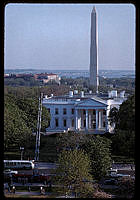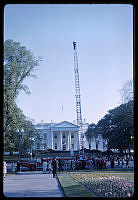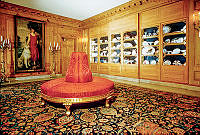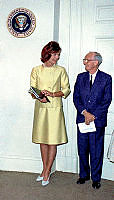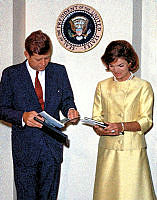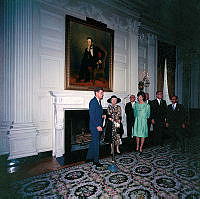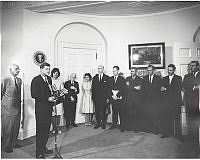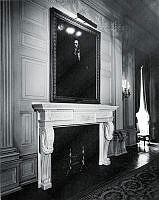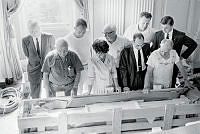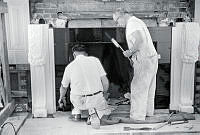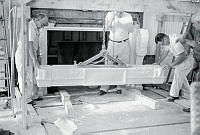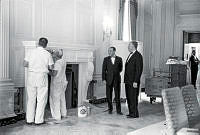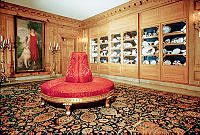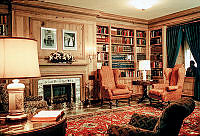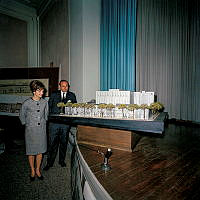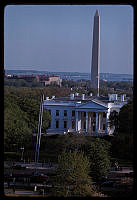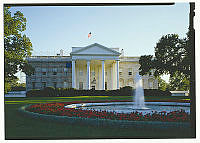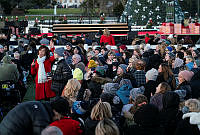The Executive Stables
Copyright © White House Historical Association. All rights reserved under international copyright conventions. No part of this article may be reproduced or utilized in any form or by any means, electronic or mechanical, including photocopying, recording, or by any information storage and retrieval system, without permission in writing from the publisher. Requests for reprint permissions should be addressed to books@whha.org
The stables, built on the White House grounds over a period of a century, were never intended to be great architecture. Public interest was keen simply because they were the president's stables. The first executive stable was a simple Georgian brick building, erected just off the grounds in 1800. Thomas Jefferson located a stable and carriage house in flanking wing dependencies built at the White House in 1806. After the British burned the White House in 1814, a frame stable was added to the end of the rebuilt west wing. In 1834, President Andrew Jackson directed the construction of a freestanding brick structure trimmed with Aquia sandstone located east of the White House.
Andrew Jackson's stable was razed in 1857 to make way for the present south wing of the Treasury Department. A new structure was built on the east grounds south of the Treasury. A tragic fire took this building in 1864, destroying the Lincoln family horses. A replacement stable was erected on the west grounds. In 1871, that structure made way for the construction of the imposing State, War and Navy Building (today's Eisenhower Executive Office Building). The last White House stable, a High Victorian mansard-roofed structure built during the Grant administration in 1871 and extended for Benjamin Harrison in 1891, was demolished in 1911.
The Last White House Stable
The gateway of the executive stables faced 17th Street, N.W. At the center of the U-shaped building was an open courtyard that was covered by glass in 1891. The stable, carriage, tack and harness rooms, and a cozy sitting room for the coachmen and stable hands were located on the first floor. An apartment for the coachman and his family were in a second story attic.
A reporter's description of the White House stables in 1889: "A few rods south of the southern entrance to the great State, War, and Navy buildings is a grove of young trees, from above the verdant tops of which peep out an odd-looking continuation of mansard roof ... the uninformed stranger wonders what manner of mansion it is which is thus secluded and finds that it is the White House stables. The stables are extensive enough to contain twenty-five horses and twelve vehicles. Nothing but a pass from the President's private secretary will secure admission to the sacred precincts where [coachman] Albert Hawkins is king." The Evening Star, Washington, D.C., April 13, 1889.

The White House Stable in 1900.

The first White House stable completed in 1800 on the corner of 14th and G Streets, N.W. was remodeled as a school in 1821 and demolished about 1886.

Thomas Jefferson outlined the White House and grounds with sweeping carriage paths and a stable to the east, 1802-1805. His grand scheme was partially realized, a stable was built in 1806 and the general layout of the grounds survived until the late 1850s.

With the White House in the background, Grant's prized warhorses, Cincinnati and Egypt, were shown centered in an engraving, Harper's Weekly, April 17, 1869.

Harness room in the Roosevelt stables, 1903. Visible in the case were President Roosevelt's harness with his monogram and cockade.

Neatness and order: Interior view of the stalls in the White House stable in 1903.

Coachman Charlie Lee supervised the groomsmen and stablemen and had charge of the care and feeding of 15 horses, eight of which were owned by the Roosevelts. Washington Post, January 7, 1906.
Library of Congress
Official White House fleet with drivers and motorcycle police in 1909 at the time the White House stable became a garage.
Smithsonian Institution












